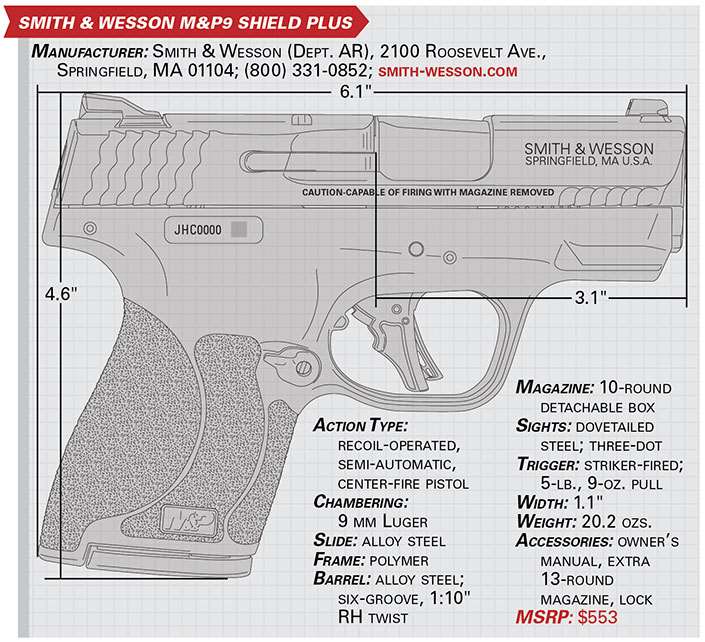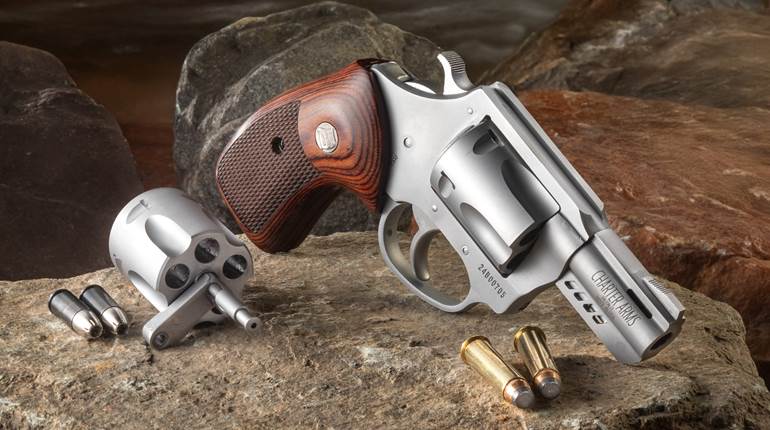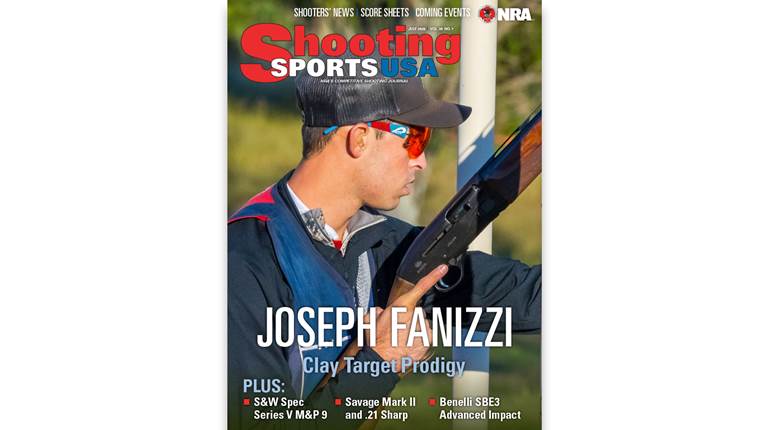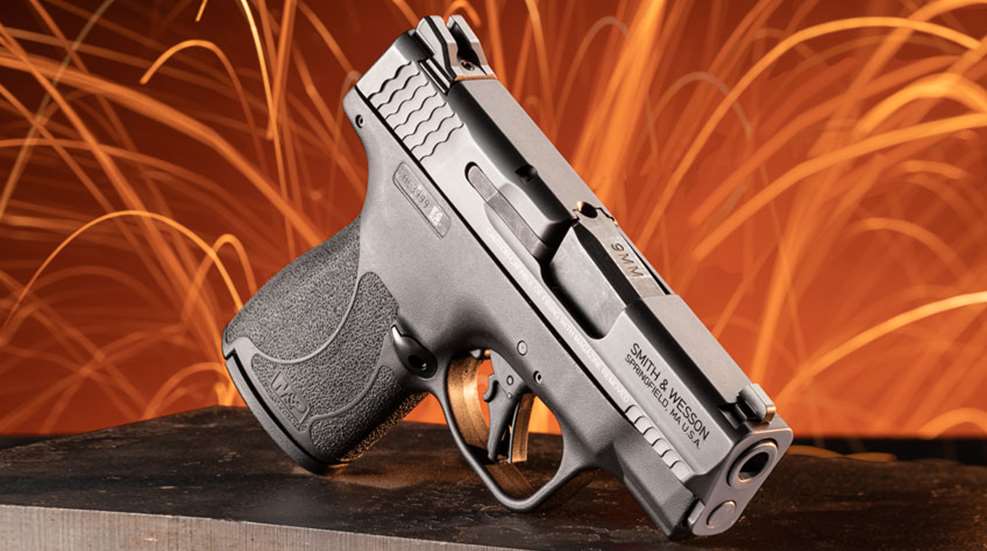
At first glance, it doesn’t look like Smith & Wesson did anything drastic. In fact, the only apparent difference about this micro-compact handgun is the word “PLUS” etched onto the slide: But don’t assume that means there aren’t others in this gun, because S&W has, in fact, taken its incredibly popular Shield pistol platform to an entirely new level. In the M&P9 Shield Plus, magazine capacity goes from single digits to double digits, all without any appreciable increase in size. This change turns what was previously a somewhat-dated design into a strong competitor against some of the most novel handguns available today.
When the M&P Shield first hit shelves in 2012, it was poised to take advantage of a primed concealed-carry market. Starting in the mid-1980s, NRA spearheaded a nationwide movement to expand concealed-carry laws at the state level, and by 2012, more than 40 states had enacted right-to-carry legislation. Those who wanted a small self-defense handgun chambered for a duty cartridge had far fewer options a decade ago. The original M&P Shield, with its slim, single-stack profile and magazine, offered a welcome balance between double-stack compacts and pocket-size semi-automatics. It was an instant success and expanded into a multi-caliber line complete with add-ons and enhancements. Competitors soon caught up, however, and the launch of guns such as the SIG Sauer P365, Springfield Armory Hellcat, Ruger MAX-9 and others meant the CCW market had multiple options that were similar or smaller in size while bringing significant increases in capacity. Smith & Wesson’s Shield Plus addresses what is undoubtedly a shortcoming in today’s market, while retaining—and in some cases even enhancing—many details that made the gun popular with consumers in the first place.
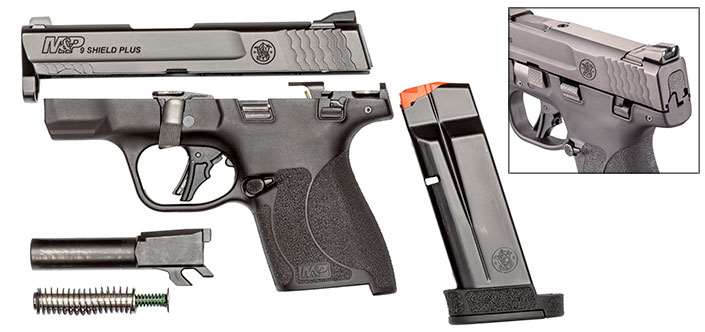
The biggest change found in the Shield Plus is, of course, the magazine itself. It’s not correct to say that S&W improved upon the original Shield’s single-stack magazine, because that gun didn’t actually use a true single-stack. To shorten the overall height of the pistol, the Shield uses a slightly staggered column that didn’t compromise the width. In the Shield Plus, the folks at Smith created what they term a “stack-and-a-half” design, evidenced by the wider body dimensions of the Shield Plus magazine versus that of the original Shield. Despite this increase, the difference in width is fairly marginal from a shooter’s perspective; at its widest point, the M&P Shield Plus measures 1.1" compared to the 0.95" width of the original Shield. With that 0.15" of extra space, magazine capacity increases from a seven-round flush-fit and an eight-round extended magazine to a 10-round flush-fit and a 13-round extended magazine. Typical of most handgun magazines, the stagger-stack design funnels into a single-feed column at the top of the magazine body. In examining this particular point on both the original Shield and the Shield Plus, it’s evident that the original design wasn’t a true single-stack, as there’s still a slight taper into a single-feed column as the top round is presented for battery. Two stamped-steel magazines are included with each Shield Plus, one 10-rounder with a flush-fit baseplate and a 13-round magazine with an extended grip sleeve. Both have witness holes on the right side of the body that indicate capacity between four to 10 rounds in two-round intervals, and the extended magazine includes an added hole to indicate full capacity at 13 rounds. A bright-orange follower tops the magazine spring, making it easy to confirm an empty magazine when viewed through the ejection port at slide lock.
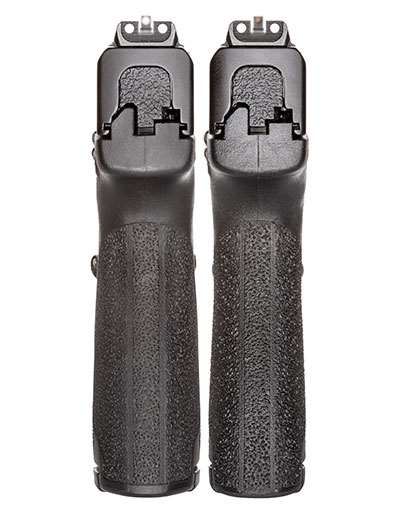
Though the “Plus” moniker highlights the added capacity found in the new design, another big plus is the new trigger. Frankly, from an external view, the most noticeable difference found on the Shield Plus for those familiar with M&P handguns is the trigger, as it’s the first in the M&P lineup to feature a bladed trigger safety. Unlike many other striker-fired handguns that incorporate a blade safety into the face of the trigger shoe, S&W stood out with its hinged trigger safety. Rather than relying on the pad of a shooter’s index finger to depress a blade, such as that found in the Glock system, S&W’s trigger safety disengaged as the shooter added pressure, hinging the lower portion of the trigger bow rearward to disengage the safety and allow the entire trigger to travel rearward. Some preferred the feel of a hinged safety, while others felt it added unnecessary travel and an unpleasant sponginess to the pull. It seems that, with the Shield Plus, S&W is moving with the rest of the pack toward the blade-in safety. Different, too, is the feel of the trigger face. The hinged-safety triggers had a rounded, curved bow that shooters either loved or hated. Given the robust aftermarket for S&W M&P triggers, enough people disliked it to spend extra cash on drop-in components to improve the overall feel. Apparently, the design team at Smith & Wesson liked their Apex triggers, too, and it shows on the Shield Plus.
Despite the move away from the hinged trigger style, S&W clearly sought to offer a balance in this new OEM trigger, and the result is an animal all its own. It’s not quite a flat-faced trigger bow, but it’s not what many would consider to be a curved bow, either. The result is a best-of-both-worlds design that provides a consistent touch point that’s comfortable and intuitive. The safety blade covers most of the trigger face and offers some resistance before sitting flush with the trigger body. Once the blade safety is disengaged, the entire assembly moves rearward smoothly until it hits a distinct wall. Apply a bit more pressure, and there’s a sharp break followed by a short amount of overtravel. After a controlled release of the trigger, there’s a notable short-reset point that shooters can both hear and feel. Both the blade safety and trigger body are molded from polymer, like S&W’s original hinged design. Due to the entirely new nature of the trigger, aftermarket options designed for use in the original M&P Shield will not work in the Shield Plus. Much of the work done on this latest Shield trigger negates the need for an aftermarket unit, though, so that may stave off the tinkerers for the time being.
Those who have spent time with the M&P M2.0 Shield platform will find many familiar features on the M&P Shield Plus. Smith & Wesson revamped its M&P lineup in 2017 with the M2.0 makeover, which incorporated new grip-frame texturing, a re-designed 18-degree grip angle and fish-scale serrations at the front and rear of the slide. For the last four years, the company held onto its M2.0 moniker, but the M&P Shield Plus retains all of these enhanced features without tacking another marketing mantra onto the slide. In fact, the texturing, grip angle, control placement and frame beavertail are all nearly identical to those found on the original Shield, which is a welcome trait for current Shield owners looking to upgrade. Controls are found on the left side of the frame, and this particular model includes a takedown lever, slide catch and a manual thumb safety. Models without a manual thumb safety are available, too. As it ships from the factory, the textured polymer magazine release is located on the left side as well, but unlike the other controls, the release button can be removed and re-installed onto the right side of the gun. All it takes is a simple one-quarter turn of the button’s retaining screw visible on the opposite side. While a nice concession for the left-handed among us, the lack of a mirrored slide stop and thumb safety means this model is of limited utility for that segment of the market. Despite the slightly increased width, S&W retained the same trigger guard dimensions as the original Shield. This particular design element was no doubt influenced by the fact that S&W’s sister company, Crimson Trace, offers a lineup of clamshell-style lasers and lights that wrap around the trigger guard of an M&P Shield by necessity, since the slim frame lacks an accessory rail.
At the top end of the Shield Plus, nothing appears to have changed dramatically. True, most of the major changes have occurred within the grip frame, but that doesn’t mean that the stainless-steel, Melonite-finished slide has been untouched. Due to the slightly wider grip frame, the slide width has been similarly altered, but to a much lesser degree than the frame. In fact, the Shield Plus will fit into all holsters designed for the standard Shield. Otherwise, most of the design carries over from the M2.0 pattern. One element of note is that S&W chose not to join the flat-faced rear sight crowd with this latest design, instead retaining the ramped rear sight found on earlier models. Adherents to this flat-sight fad contend that the feature allows for one-handed racking off a flat surface should one hand be disabled in a gunfight. Such a scenario is certainly within the realm of possibility, but a more likely outcome is a torn-up palm from riding over the sharp edges of a rear sight while racking. With the Smith & Wesson, there’s no such discomfort, but those who feel the need for such a tactical feature will not find it in the Shield Plus. Fortunately, there are plenty of options on the aftermarket. As it stands, the Shield Plus offers a standard three-dot, all-steel sight arrangement dovetailed into the slide with a glare-reducing serrated face on the rear sight.
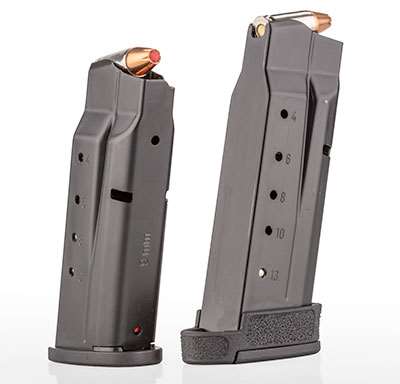
To evaluate the performance of the M&P Shield Plus, we received the company’s base-model gun equipped with a thumb safety. Though exact numbers weren’t available at press time, Smith & Wesson plans to roll out several models that incorporate optics-ready slides, Performance Center enhancements and more. All of the variants will be chambered in 9 mm Luger. Ultimately, American Rifleman received two examples of the Shield Plus, both sourced from early production runs, and multiple shooters fired both guns in an effort to solicit different opinions regarding its performance. At the time of this writing, the United States is currently experiencing one of the most severe ammunition shortages in recent memory. As a result, round counts are somewhat lower than would otherwise be fired in a thorough test of a new model. Ultimately, about 350 rounds were fired through the new S&W Shield Plus.
Strictly from a capacity standpoint, the M&P Shield Plus is already an improvement over the original, even if every other element of the gun remained unchanged. But S&W’s dimensional changes, combined with the new trigger design, make the gun better still. In creating this capacious concealed-carry companion, the design team at S&W kept what worked while making a platform that’s an eminently better shooter than its slightly slimmer sibling. Adding 0.15" to the width of a grip frame doesn’t sound significant, and in some important ways, it isn’t. During daily carry, such a small difference in overall dimensions won’t matter when it comes to concealment and carry comfort. Where it comes into play is on the range. The original M&P Shield had a bit of a reputation for being not only “snappy” but also somewhat brutal on the hand during longer strings of fire. On the new Shield Plus, the added width at the back of the frame spreads out recoil energy across a larger portion of the hand, so there isn’t as much of a punch when the shot breaks.
Even getting to the break is a greatly improved journey. Smith’s team did a great job on this new trigger. As far as factory triggers go, this is certainly one of the better ones out there at the moment. Not only was pull weight manageable, it was remarkably consistent. Plus, the clean, short-reset point made follow-up shots a breeze, both in terms of speed and accuracy. However, the take-up isn’t so short that you’ll accidentally squeeze off a second shot unintentionally. It simply provides an intuitive intermediate stop that cuts out all sympathetic movement experienced during full trigger travel.
Because of the tight tolerances on these small-size guns, S&W doesn’t have room to incorporate the interchangeable grip panels it offers on larger pistols. In its place are one-size-fits-all ergonomics that actually fit pretty well. There are issues, however, with access to some controls, particularly when different hand sizes come into play. To put it bluntly, the safety on the Shield Plus, like that found on the lower-capacity Shield, leaves a lot to be desired. Though the safety eventually loosened-up during our testing, the control’s low profile combined with scant texturing and heavy fencing made it difficult to engage and disengage. Slide-racking on the Shield Plus, though slightly easier than it was on the original Shield, still requires quite a bit of effort. Fortunately, S&W has alternatives in its Shield EZ line for those who lack the hand strength to draw the slide fully to the rear.
Range performance was also largely dependent upon which magazine was in the gun. Different shooters will have different impressions, depending on their hand size, but those with medium-to-large hands will find it more difficult to obtain a full three-fingered grip with the flush-fit magazine, despite the rather generous trigger guard undercut. The additional length obtained with the extended magazine makes it much more comfortable to shoot at the expense of concealability, as the heel of the frame tends to be the most likely part of the gun to print through clothing.
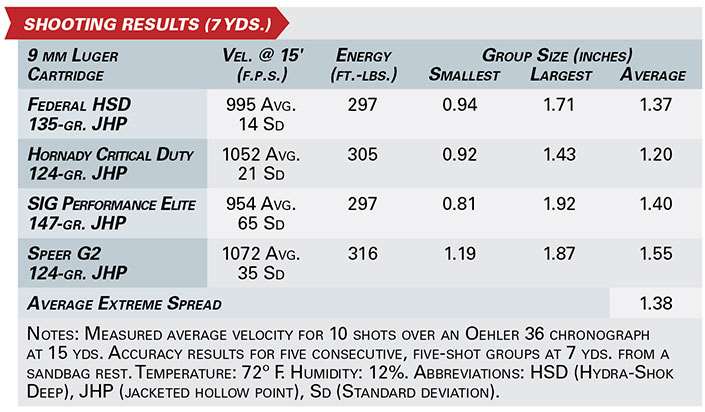
Nowhere on the Shield Plus is it marked for use with +P loads, and the only indication that +P loads are acceptable is found in the manual, in which S&W merely mentions that such rounds will increase wear on firearm components. The company does explicitly state, however, that +P+ loads are not to be fired in this gun. We fired a number of +P defensive loads through the Shield Plus, and while the hotter rounds were noticeable compared to standard-pressure loads, they did not produce excessive recoil.
Concealed-carry guns are the hottest corner of the firearm market, and it’s likely they’ll remain so for the foreseeable future. Smith & Wesson gained a large chunk of that market early on by meeting the needs of armed citizens in 2012 with the first M&P Shield, and the company has shown that it’s keeping pace with the latest demands in both features and capacity. Sure, there are smaller guns out there, but some designs have shown that it’s possible to be a little too small. At the end of the day, the CCW gun that saves your life isn’t just the one you carry, it’s the one you know how to shoot. Not only is the M&P9 Shield Plus small enough for all-day carry, it has the ammunition capacity necessary to handle most any defensive scenario.
